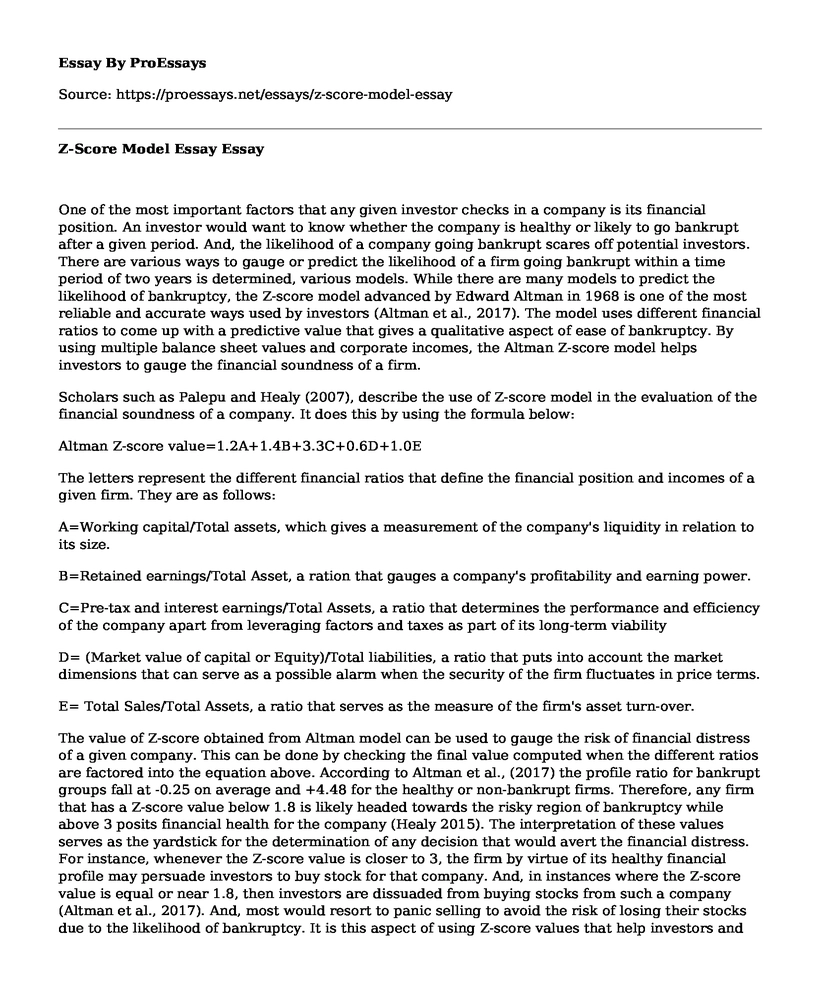One of the most important factors that any given investor checks in a company is its financial position. An investor would want to know whether the company is healthy or likely to go bankrupt after a given period. And, the likelihood of a company going bankrupt scares off potential investors. There are various ways to gauge or predict the likelihood of a firm going bankrupt within a time period of two years is determined, various models. While there are many models to predict the likelihood of bankruptcy, the Z-score model advanced by Edward Altman in 1968 is one of the most reliable and accurate ways used by investors (Altman et al., 2017). The model uses different financial ratios to come up with a predictive value that gives a qualitative aspect of ease of bankruptcy. By using multiple balance sheet values and corporate incomes, the Altman Z-score model helps investors to gauge the financial soundness of a firm.
Scholars such as Palepu and Healy (2007), describe the use of Z-score model in the evaluation of the financial soundness of a company. It does this by using the formula below:
Altman Z-score value=1.2A+1.4B+3.3C+0.6D+1.0E
The letters represent the different financial ratios that define the financial position and incomes of a given firm. They are as follows:
A=Working capital/Total assets, which gives a measurement of the company's liquidity in relation to its size.
B=Retained earnings/Total Asset, a ration that gauges a company's profitability and earning power.
C=Pre-tax and interest earnings/Total Assets, a ratio that determines the performance and efficiency of the company apart from leveraging factors and taxes as part of its long-term viability
D= (Market value of capital or Equity)/Total liabilities, a ratio that puts into account the market dimensions that can serve as a possible alarm when the security of the firm fluctuates in price terms.
E= Total Sales/Total Assets, a ratio that serves as the measure of the firm's asset turn-over.
The value of Z-score obtained from Altman model can be used to gauge the risk of financial distress of a given company. This can be done by checking the final value computed when the different ratios are factored into the equation above. According to Altman et al., (2017) the profile ratio for bankrupt groups fall at -0.25 on average and +4.48 for the healthy or non-bankrupt firms. Therefore, any firm that has a Z-score value below 1.8 is likely headed towards the risky region of bankruptcy while above 3 posits financial health for the company (Healy 2015). The interpretation of these values serves as the yardstick for the determination of any decision that would avert the financial distress. For instance, whenever the Z-score value is closer to 3, the firm by virtue of its healthy financial profile may persuade investors to buy stock for that company. And, in instances where the Z-score value is equal or near 1.8, then investors are dissuaded from buying stocks from such a company (Altman et al., 2017). And, most would resort to panic selling to avoid the risk of losing their stocks due to the likelihood of bankruptcy. It is this aspect of using Z-score values that help investors and companies know the valuation process and the decision-making steps to take to avoid any instance of surprises when bankruptcy strikes.
A company may use the Z-stock value to make valuation judgments. For instance, if the company realizes that its Z-score value is almost equal to 1.8, it may take necessary actions on ways to increase its capital base through means such as borrowing from the public or government. It may also opt to conduct austerity measures as part of preventing the eminent financial distress. Also, when the Z-score is high, a company is able to know that it is headed in the right direction with its financial management and operations.
There are various cases where the Z-score value has been used to predict the financial soundness of a company. However, the most common are predictions made by Altman about the financial meltdown of 2008. Based on the calculations of Z-score values of most companies in 2007, it was noted that their Z-score values were lower. And, hence most companies were headed for bankruptcy. This was later to happen in 2009 when the meltdown affected the credit market and hence the global recession.
References
Altman, E.I., IwaniczDrozdowska, M., Laitinen, E.K. and Suvas, A., 2017. Financial Distress Prediction in an International Context: A Review and Empirical Analysis of Altman's ZScore Model. Journal of International Financial Management & Accounting, 28(2), pp.131-171.
Healy, P.M., 2015. Discussion of "On Guidance and Volatility". Journal of Accounting and Economics, 60(2-3), pp.136-140.
Palepu, K.G. and Healy, P.M., 2007. Business analysis and valuation. Cengage Learning EMEA.
Cite this page
Z-Score Model Essay. (2022, May 26). Retrieved from https://proessays.net/essays/z-score-model-essay
If you are the original author of this essay and no longer wish to have it published on the ProEssays website, please click below to request its removal:
- Research Paper on Investments: Bayer AG Company. The SIX Corporate Bonds.
- The Economic Implications of Government Control Over the Interest Rates Essay
- Audit of Inventory, Warehousing and Payroll Accounts and Cycles of Starbucks Company - Research Paper
- Paper Example on Sleezy & Sly Co.: Unethical Use of Illegally Acquired Tax Package
- Essay on Establishing Effective Healthcare Organisation: Risk Control Through Auditing
- Essay Example on Hedge Funds: Performance, Risks and Regulations
- Report Example on Cryptocurrency Formation







